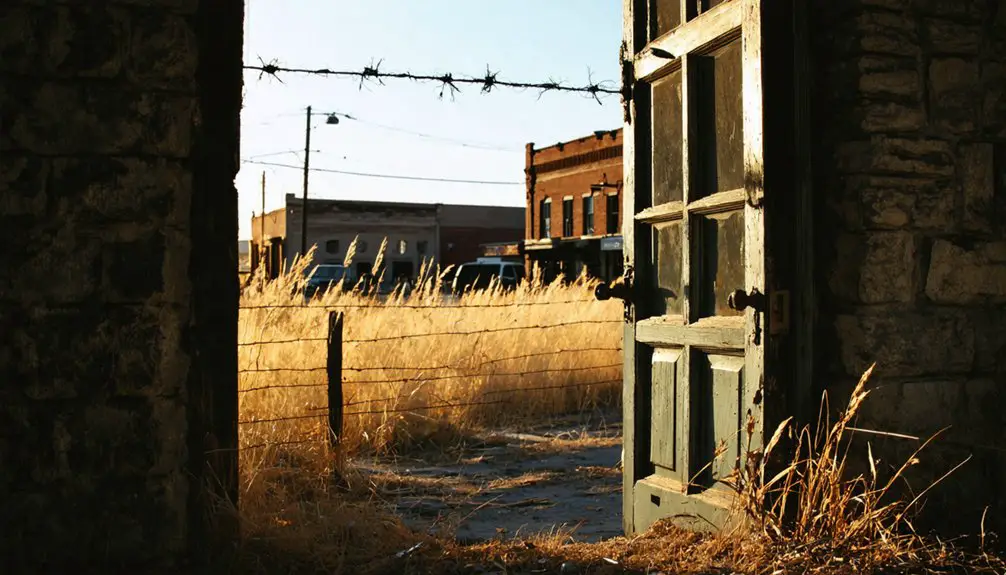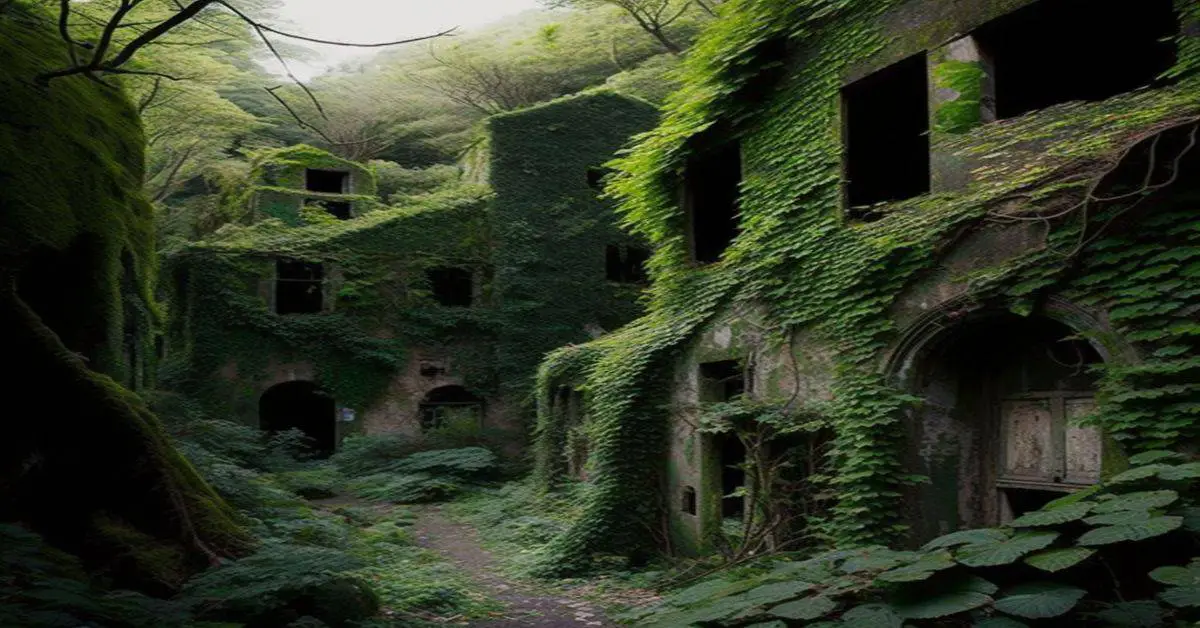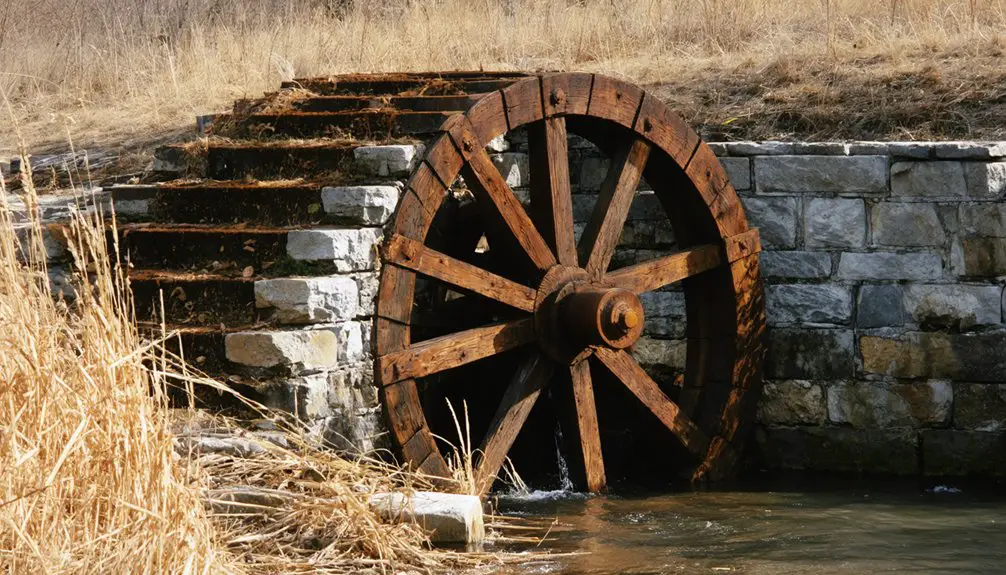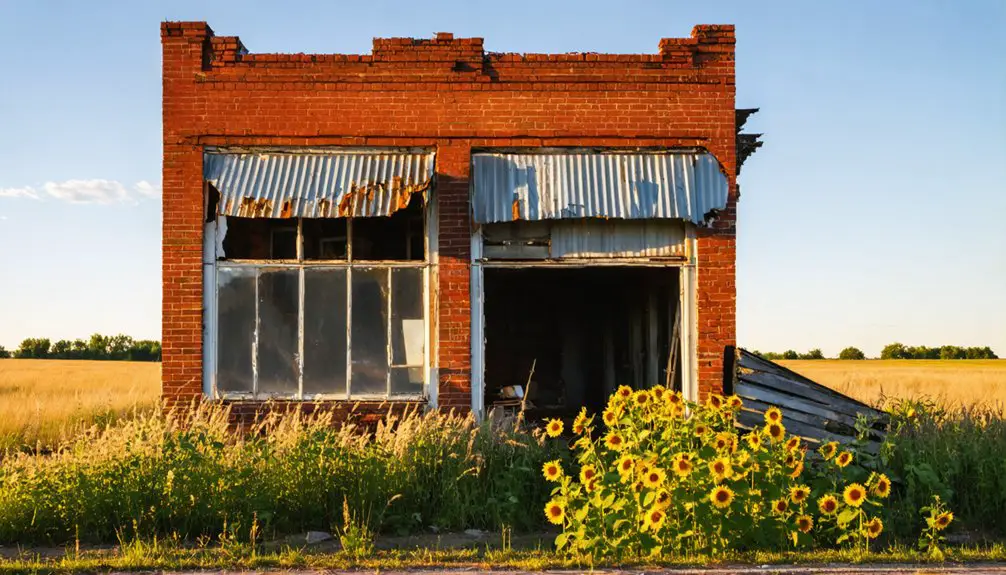You’ll find the ghost town of Zarah along the Santa Fe Trail near Great Bend, Kansas, where Fort Zarah once stood guard in 1864. The military outpost evolved into a small settlement after 1869, complete with a trading post and post office. Though only ten residents called it home by 1871, Zarah’s role in frontier defense and buffalo hunting left an indelible mark on Kansas history. The fort’s sandstone ruins and archaeological discoveries tell a fascinating tale of frontier life.
Key Takeaways
- Zarah began as a military fort in 1864, evolved into a settlement by 1870, but maintained only ten residents during its peak.
- The town emerged after Fort Zarah’s closure in 1869, when pioneers from Ellsworth, Kansas settled the area.
- Buffalo hunters formed most of Zarah’s population, with early settlers including Titus Buckbee and Edward J. Dodge.
- The community established a post office in 1871 but struggled with economic sustainability and population growth.
- Zarah’s location at Walnut Creek Crossing hosted trading posts that served military, settler, and Native American commerce.
The Birth of Fort Zarah and Its Military Legacy
While tensions mounted along the Kansas frontier in 1864, Fort Zarah emerged as an essential military outpost where the Santa Fe Trail crossed Walnut Creek.
Initially called Camp Dunlap, you’d find this strategic fort near today’s Great Bend, where it played a pivotal role in the region’s military significance.
Named after Maj. H. Zarah Curtis, who fell during the Baxter Springs Massacre, the fort grew from simple tents and dugouts into an impressive sandstone structure by 1866. Built from materials quarried nearby, the fort’s two-story structure stretched 116 feet in length.
Throughout its brief but impactful existence, you’d witness soldiers defending against fierce Kiowa attacks, including notable battles in 1867 and 1868.
The fort’s presence shaped Native American relations as troops patrolled the Santa Fe Trail, protecting settlers and merchants until changing times led to its closure in 1869. The massive 3,700 acre reservation surrounding the fort was established on September 30, 1868.
From Fort to Town: The Rise of Zarah Settlement
After Fort Zarah’s closure in 1869, settlers from Ellsworth, Kansas, seized the opportunity to establish a new town near the fort’s historic grounds.
You’d have found pioneers like Titus Buckbee and Edward J. Dodge among the first to stake their claims, driven by dreams of wealth through land ownership and town development.
Life wasn’t easy for these early settlers. Buffalo hunters made up most of the population, selling meat locally and shipping hides east.
When farmers tried their luck, they watched helplessly as buffalo trampled their crops and wallowed in freshly plowed fields.
Despite these economic challenges, the settlement managed to secure a post office by 1871, though the population remained small at just ten residents.
The town was established in 1870 and named after Fort Zarah which had protected settlers from Indian attacks.
The town’s businesses included several key stores, including a blacksmith shop, grocery, and livery stable.
Settler motivations of prosperity ultimately couldn’t overcome the growing shadow of nearby Great Bend.
Trading Posts and Early Commercial Development
Before Fort Zarah became a military stronghold, you’d have found a bustling trading post at Walnut Creek Crossing where the Santa Fe Trail met the Arkansas River. William Allison and Francis Boothe established this essential outpost by 1855, building it into a fortified ranch that could withstand the region’s frequent conflicts.
The trading post dynamics reflected the complex relationship between settlers and Native American tribes. You’d have seen Kiowa, Comanche, and Arapahoe traders frequenting the area’s salt springs, creating a hub of indigenous commerce. The post became especially known for its wolf killing and fur business. The ranch changed hands several times over the years, becoming known as the Peacock Trading Post under different operators.
Despite the occasional hostilities, this crossing served as a crucial exchange point along the Santa Fe Trail. While the post eventually burned in 1868 during an attack, it had already cemented its place in history as the foundation for Zarah’s development.
The Zarah Hotel’s Final Chapter
During its golden years in the 1920s and ’30s, you’d have found the Zarah Hotel standing proudly as Great Bend’s premier lodging establishment, boasting 50 modern rooms across three stories.
You would’ve witnessed its ambitious expansion adding 32 more rooms and prime commercial space along Main Street, marking the peak of its hotel history.
But time wasn’t kind to this landmark. While the hotel persevered through various management changes under the Poland family’s guidance, operational challenges eventually took their toll. Recent preservation efforts have focused on accessibility solutions to make the historic building more inclusive for all visitors.
By the 1970s, the guest rooms fell silent as the Zarah ceased its lodging operations. Though the first floor adapted to retail and office space, the upper floors were abandoned. The hotel faced closure due to serious safety issues including unvented heaters and electrical problems.
Today, while the building stands as a symbol of Great Bend’s past prosperity, it’s preserved within the Kansas Register of Historic Places.
Preserving the Memory of a Frontier Outpost
While Fort Zarah‘s stone walls no longer stand guard over the Santa Fe Trail, its legacy lives on through dedicated preservation efforts spanning generations.
The fort’s construction in 1867 cost $110,000 to expand and strengthen the military presence along the trail.
The fort’s strategic location along Barton County’s main routes made it a vital defensive position.
You’ll find archaeological significance in the discoveries from 1969 excavations, which unearthed fort footings, brownish stones, and square-headed nails near Walnut Creek Crossing. These artifacts tell stories of frontier life and early settler-indigenous interactions.
Through community involvement, local historical societies and descendants of pioneers like the Buckbee family keep the fort’s memory alive.
You can visit the historical marker 1.5 miles east of Great Bend, where interpretive signs help you imagine the bustling military outpost that once protected travelers along the trail.
Though urban development and farming threaten the site’s integrity, preservation efforts continue through museums, blogs, and official historical records.
Frequently Asked Questions
What Were the Daily Living Conditions Like for Soldiers at Fort Zarah?
You’d face basic barracks conditions in the sandstone fort, sharing cramped quarters while eating standard soldier diet rations. Your daily routine revolved around patrol shifts and maintaining readiness against Native American attacks.
How Many Civilians Actually Lived in Zarah During Its Peak Population?
Like a lone star on the Kansas prairie, you’d have found about 50 souls calling Zarah home during its peak population around 1910, when railroad activity spurred modest demographic growth.
What Specific Native American Tribes Frequented the Zarah Trading Post Area?
You’d find the Kiowa leading trade relations around Fort Zarah, alongside Comanche warriors, Arapahoe bands, and Cheyenne groups who all frequented the area’s essential trading posts and salt springs.
Were There Any Documented Paranormal Experiences at the Abandoned Zarah Hotel?
You won’t find any documented ghostly encounters or haunting stories at the Zarah Hotel. Despite its abandoned state and potential for spooky tales, there’s no verified evidence of paranormal activity there.
What Artifacts From Fort Zarah and the Town Still Exist Today?
You’ll find square-headed nails, broken glass, military buttons, firearm parts, and crumbling stone foundations scattered across wheat fields, preserving Fort Zarah’s historical significance through these weathered artifacts of frontier freedom.
References
- http://kansasghosttowns.blogspot.com/2014/05/a-little-history-on-fort-zarah-allison.html
- https://www.legendsofamerica.com/fort-zarah-kansas/
- https://en.wikipedia.org/wiki/Fort_Zarah
- https://abandonedks.com/zarah-hotel/
- https://www.hmdb.org/m.asp?m=55315
- http://www.ksgenweb.org/archives/1912/f/fort_zarah.html
- https://scholars.fhsu.edu/theses/816/
- https://legendsofkansas.com/barton-county-kansas/
- https://historic-trails.unm.edu/sites/walnut-creek-crossing.html
- https://publications.kon.org/urc/hetzke.html



